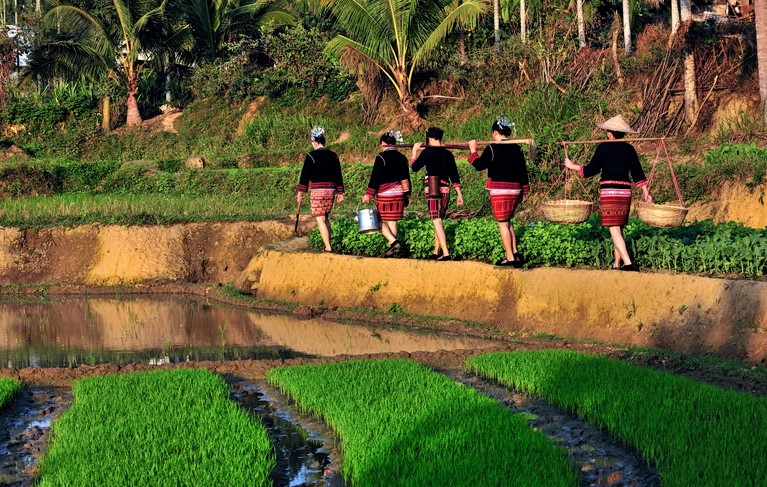Written by Juliette Qi
Dongba Culture and Naxi Ethnicity
In China, the Dongba culture, associated with Lijiang City in the Yunnan Province and Muli District in the Sichuan Province, refers to the traditional culture of the Naxi ethnic group. The Naxi live mostly in northern Yunnan, in Lijiang, Weixi, Zhongdian, Ninglang and Yongsheng prefectures.

The Dongba culture is based on the polytheistic religion of the same name and also has own writing, dances, paintings and music. “Dongba” is the name given to shamans, types of wizards, who transmit this culture from generation to generation. The Dongba priest is an important figure in the community because he preaches the harmony between men and nature, which is a fundamental value among the Naxi people, just like the cult of the ancestors.
The Dongba religion, more than a thousand years old, has been influenced by Tibetan Lamaism over the centuries, but also by Taoism and Chinese Buddhism. In this religion, the elements of nature are considered as gods who rule the world.

From an artistic perspective, Dongba culture is indeed very rich because it is transmitted and expressed by music and painting. Many colorful scrolls depicting religious scenes or deities can be found in Lijiang.
The city of Lijiang is a research center which studies the Dongba culture and keeps all objects related to this culture. Many Chinese and foreign researchers come to this place to study this fascinating culture. In religious rituals, the Naxis dance in their traditional costumes reminiscent of Tibetan ones. They also sing sacred texts, written in Dongba.
Dongba Writing: The Legendary Characters

The dongba or tomba script (in romanized Naxi: ‘na-‘khi ²ggŏ-¹baw) is one of the scriptures used to write in the Naxi language, which is spoken by the Naxi people. It is more than 1000 years old and is probably the only predominantly pictographic writing system used today; however, some characters are used as syllabic characters.
There are currently 2000 religious works written in the Dongba language in which more than 2000 pictograms are used. These books are of crucial importance to understand the Dongba culture because they inform us about religion and customs but also about philosophy, history, literature, astronomy, medicine, fauna and flora as well as the paintings and music of this culture.
In the Lijiang prefecture in particular, the signs are usually written in dongba, han Chinese and sometimes in English. There are also dongba – hanzi / english dictionaries in the bookstores of the city.

Dongba calligraphy is still practiced by using bamboo stencils, as well as prints, both of which usually use a high-quality handmade paper specifically made for Dongba.
The traditional production of dongba paper uses the bark of two shrubs, wikstroemia delavayi and wikstroemia lichiangensis, growing at an altitude of 2,000m above sea-level, as in the canton of Sanbei. The barks are cut into thin strips, soaked in a tray, and then dried on boards in the sun. There are also many murals of this writing, in bas-relief or painting.
About Interact China
“A Social Enterprise in E-commerce Promoting Oriental Aesthetic Worldwide”
Aileen & Norman co-founded Interact China in 2004 with specialization in fine Oriental Aesthetic products handmade by ethnic minorities & Han Chinese. Having direct partnerships with artisans, designers, craft masters and tailors, along with 10 years solid experience in e-commerce via InteractChina.com, we position well to bridge talented artisans in the East with the rest of the world, and bring you direct finely selected products that are of good quality and aesthetic taste.
So far we carry 3000+ goods covering Ladies Fashion, Kungfu Clothing, Home Furnishings, Babies & Kids, Painting Arts, Textile Arts, Carving Arts, Tribal Jewelry Art, Wall Masks and Musical Instruments. Our team speak English, French, German, Spanish and Italian, and serve customers worldwide with passion and hearts.
P.S. We Need People with Similar Passion to Join Our Blogging Team!
If you have passion to write about Oriental Aesthetic in Fashion, Home Decor, Art & Crafts, Culture, Music, Books, and Charity, please contact us atbloggers@interactchina.com, we would love to hear from you!













































 The filigree work is typically hand-fashioned with tweezers using silver wires which are shaped into flowers, butterflies and other subjects. At approximately 1700 degrees F, the wire structure is then carefully fired in a kiln where they are fused together with silver dust. This first process provides the framework for the piece. Fine enamel powder is then blended and packed into the frame, and briefly fired in the kiln again several times at 1500 degrees F. During this second firing, the enamel fuses into a durable glasslike finish.
The filigree work is typically hand-fashioned with tweezers using silver wires which are shaped into flowers, butterflies and other subjects. At approximately 1700 degrees F, the wire structure is then carefully fired in a kiln where they are fused together with silver dust. This first process provides the framework for the piece. Fine enamel powder is then blended and packed into the frame, and briefly fired in the kiln again several times at 1500 degrees F. During this second firing, the enamel fuses into a durable glasslike finish.



